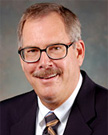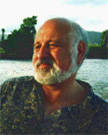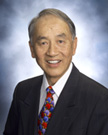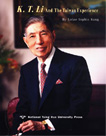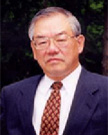
Dr. Nam Pyo Suh is the President of the Korea Advanced Institute of Science and Technology (KAIST). He assumed this position on July 13, 2006 and was reappointed for another four-year term in 2010. He is also the Ralph E. & Eloise F. Cross Professor, Emeritus, M.I.T.
Since his inauguration, Dr. Suh has made the goal of making KAIST one of the best science and technology universities in the world. To achieve this goal, he has made a number of important changes in governance, academic structure, curriculum, faculty tenure policy, and research structure of KAIST. He has initiated major research and educational activities in energy, environment, water, and sustainability (EEWS) and healthcare, education, and defense (HED), in addition to strengthening the fields related to IT, BT, NT, and complex systems. He created the KAIST Institute to promote multi- and cross-disciplinary research in emerging fields. During the period 2006 to 2012, he increased the number of the faculty members at KAIST by 50% from 409 to 600 by hiring 279 new, mostly young professors. He increased its annual budget from about $300 million to $740 million a year and doubled its asset to over $1 billion. The research volume was increased by a factor of about 2.5 (from about $118 million to $258 million) during the same period, increasing the overhead income by a factor of more than four. He also added a number of new departments to lead KAIST into new frontiers of knowledge. Under his leadership, eleven new buildings (The BJ and Chunghi Park KI Bldg., the Pappalardo Medical Center, Apartments for International Faculty, two Undergraduate Dormitories, The BH Kim IT Building, animal facility, International Center, The GC Liu Sports Complex, MS Chung Building II, The Natural Science Bldg.) were either constructed or being constructed, increasing the floor space of KAIST by nearly 50%. Also old buildings were renovated to expand the space for cultural science fields. Several new departments and graduate schools were created, including the Departments of Ocean Systems, Knowledge Systems Engineering, and the Graduate Schools for Green Transportation, and Nano Science and Technology. He has also increased the funding from government and private sources. He also created Distinguished Professorships and chaired professorships.
In 2007, KAIST received the highest award from the President of Korea for its contributions. Under his leadership, KAIST's worldwide ranking conducted by QS/London Times has jumped from around 200 to 69th overall and 21st in engineering in 2009. At KAIST, he invented the On-Line Electric Vehicle (OLEV), which was selected one of the 50 Best Inventions of 2010 by the Time magazine, and Mobile Harbor (MH), which was ranked second in the "10 best start-up ideas of 2011" by StartupSmart, an Australia-based consultancy firm. He successfully executed the merger of ICU and KAIST in 2009. Also KAIST's asset doubled to more than $1 billion in 2009. He was a member of the Presidential Committee on Science and Technology of Korea (2009-2010) and the chairman of the Commission for New Economic Growth of the Ministry of Economy and Knowledge (2008-2009). He was also the President of Accreditation Board of Engineering Education of Korea (ABEEK). Previously, he had been at MIT since 1970, where he was the Ralph E. & Eloise F. Cross Professor, Director of the Park Center for Complex Systems (formerly the Manufacturing Institute), and the Head of the Department of Mechanical Engineering for ten years from 1991 to 2001. He was also the Founding Director of the MIT Laboratory for Manufacturing and Productivity (1977-1984), the Founder and Director of the MIT-Industry Polymer Processing Program (1973-1984), Head of the Mechanics and Material Division of the Mechanical Engineering Department (1975-1977), and a member of the Engineering Council of MIT (1980-1984 and 1991-2001).
In October 1984, Professor Suh took a leave of absence from MIT to accept a Presidential Appointment at the National Science Foundation where he was in charge of engineering. President Ronald Reagan appointed him to this position and the U.S. Senate confirmed his appointment. During his tenure at NSF, he created a new direction for the Engineering Directorate and introduced a new organizational program structure for supporting engineering research in order to strengthen engineering education and research and "to insure that the United States will occupy a leadership position in engineering well into the 21st century." He returned to MIT in January 1988. For his contributions, he received the Distinguished Service Award of the National Science Foundation. During his tenure (from 1991 to 2001) as the Head of the Department of Mechanical Engineering at MIT, the Department redefined the discipline of mechanical engineering to be more effective in the information and biology era of the 21st century. His goal was to transform mechanical engineering from a physics-based discipline into one based on physics, information, biology, and design science. A new curriculum was established and an endowment fund was created to support book-writing and teaching-material development activities of the faculty. Oxford University Press under the MIT/Pappalardo Series of Mechanical Engineering Books publishes these books. In addition, endowed undergraduate laboratories (i.e., the Pappalardo Laboratories, the Der Torossian Computational Laboratory, the Cross CAD/CAM Laboratory, and the AMP Laboratory) were created that changed the quality of undergraduate education at MIT. To strengthen research activities of the Department, the d'Arbeloff Laboratories for Information Systems and Technology, the Laboratory for Bio-instrumentation System, the Rohsenow Heat and Mass Transfer Laboratory, the Laboratory for 21st Century Energy, the Hatsopoulos Microfluids Laboratory, and the Center for Innovation in Product Development were established. He significantly increased the number of endowed faculty chairs, the endowment, and the research volume of the Department. Many generous donors supported these initiatives. More than twenty outstanding young faculty members joined the department during his tenure, a half of whom had degrees outside of the mechanical engineering field.
Professor Suh has taught axiomatic design, polymer processing, and tribology to many university professors and a large number of industrial engineers at major corporations all over the world. He taught axiomatic design at Ford, Mercedes Benz, Corning Glass, Alcoa, SAAB, Tetrapak, Ericsson, ABB, Daewoo, SVG, GM, Telemecanique, Lockheed Martin, NASA, DoD, Delphi, and others. Many of these organizations have adopted the axiomatic design principles in their work. Dr. Shu has given a large number of lectures throughout the world, including at the World Economic Forum, many professional societies, and universities.
Professor Suh was a Series Editor for the Advanced Manufacturing Series and an Editor of the MIT/Pappalardo Series in Mechanical Engineering of Oxford University Press. He was also the Founding Co-Editor-in-Chief of the International Journal, Robotics and Computer-Integrated Manufacturing from 1981 to 1996, and also serves on editorial boards of many journals.
He is a member of the Board of Directors of Axiomatic Design Software, Inc., and Parker Vision, Inc. He is a member of the Board of Trustees of King Abdullah University of Science and Technology (KAUST) and a member of the International Advisory Board of the King Fahd University of Petroleum and Minerals (KFUPM) of Saudi Arabia, and the Khalifar University of Science, Technology and Research (KUSTAR) of UAE. He has been a consultant for many industrial firms. He was a member of the board of directors of Silicon Valley Group, Inc., Therma Wave, Inc., the founder and member of the board of directors of Trexel, Inc., Integrated Device Technologies, and Triboteck, Inc. He is a Fellow of the University of Tokyo. He is also a board member of the International Advisory Board of King Fahd University of Petroleum and Minerals (KFUPM). He is an Honorary Professor at Yanbian University of Science and Technology, China; Honorary Professor of the University of Hong Kong; Advisory Professor of Shanghai Jiaotong University, China. He was an Eminent Visiting Professor at the Korea Advanced Institute of Science and Technology, Korea. He has been on visiting committees of Georgia Institute of Technology, Stanford University, the University of Michigan, and the University of California - Berkeley. He was a member of the DoD Panel on Global War on Terrorism and served on a research award committee of ASEE. He was a consultant of the Lawrence Livermore National Laboratory and Korea Electric Power Research Institute. He was a member of the Visiting Committee for the National Institute of Standards and Technology (a statutory committee). In addition, he was a member of the Development and Advisory Council of the Texas A&M University Department of Mechanical Engineering, a member of the Science Board of MacroChem Corporation. He served on advisory committees of the Lawrence Livermore National Laboratory, the Idaho National Engineering Laboratory, and Alcan Aluminum Corporation. He was a member of several NRC and NAE committees. He was also the chairman of the ASME Productivity Committee. He was a member of the Scientific Committee of the ENDREA Program of Sweden. He also evaluated a Kplus Center in Austria. He has consulted extensively for governments, the World Bank, the United Nations, universities, and many industrial firms throughout the world on various technical matters, the development of economic policies, and the creation of new products and processes. He was the architect of the Five-Year (1980-85) Economic Development Plan of the Republic of Korea. Professor Suh was educated at Buckingham, Browne and Nichols School (1955), MIT (S.B., 1959, and S.M., 1961) and Carnegie-Mellon University (Ph.D., 1964). Prior to joining the MIT faculty, Professor Suh was with the University of South Carolina (1965-1969), USM Corporation (1961-1965), and Guild Plastics, Inc. (1958-1960, part-time). He is a Fellow and was also a Visiting Professor at Tokyo University, Japan (1989) and Yonsei University, Korea (2001). He was the William Mong Distinguished Fellow at the University of Hong Kong (2002). While at Guild Plastics during his undergraduate years, he invented the foam/straight lamination/forming process, which became a major industrial process, having produced over tens of billions of plastic parts. At USM, he invented the high-pressure USM foam molding process. USM Corporation sponsored his doctoral study and research at Carnegie-Mellon University. Other industrial firms are using his other inventions. He is a U.S. citizen. Their main residence is in Sudbury, Massachusetts, U.S.A.




